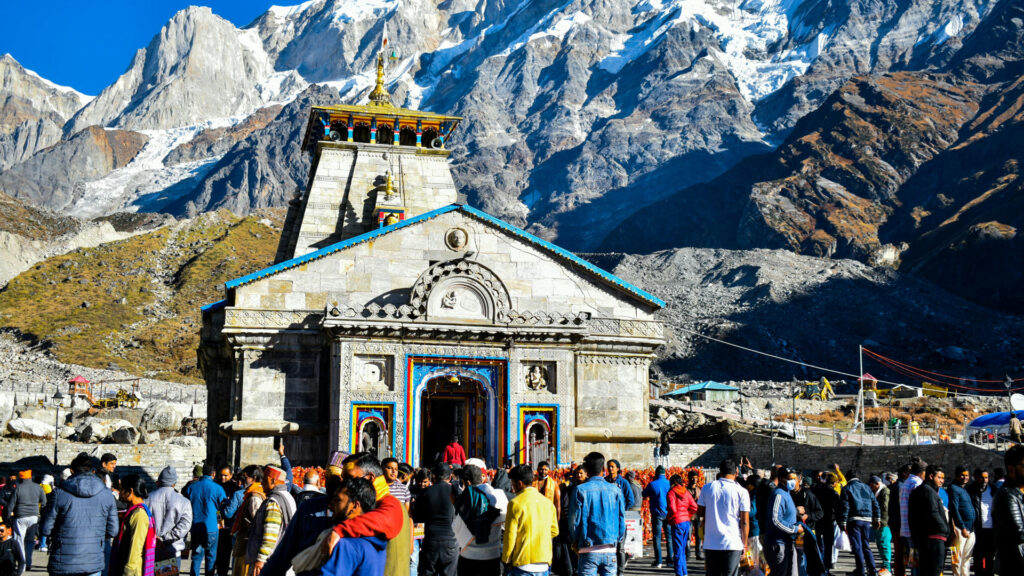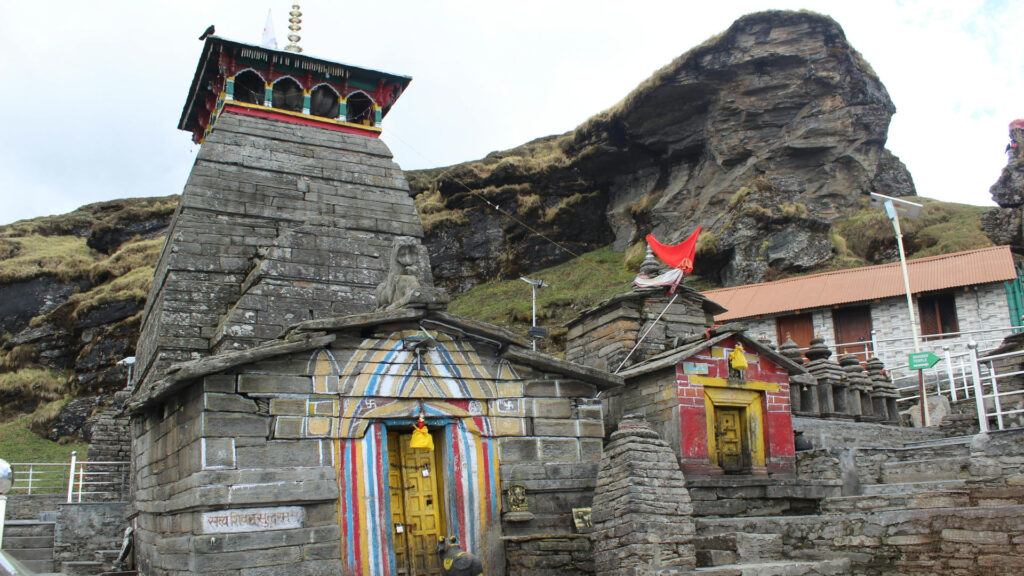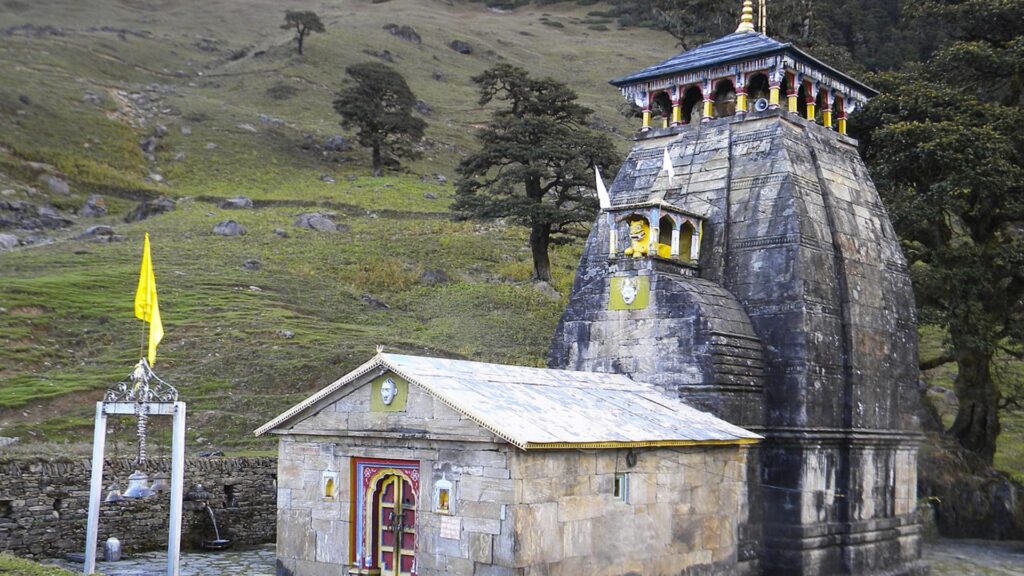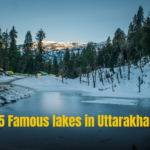In the Garhwal region of Uttarakhand, India the Panch Kedar, the five temples dedicated to lord Shiva, are located. These five temples of Panch kedar in Uttarakhand are;
- Kedarnath Temple which has an altitude of 3583m.
- Tungnath Temple is the highest temple, located at an altitude of 3680m.
- Rudranath Temple is located at an altitude of 2286m.
- Madhyamaheshwar Temple which is located at a distance of 3490m.
- Kalpeshwar Temple which lies at an altitude of 2200m.
This is the order in which these temples are visited. It is believed that the Pandavas of Mahabharat built these temples, which is why Panch Kedar in Uttarkhand is very important in the Indian pilgrimage.
Brief information about Panch Kedar temples
1. Kedarnath

The Kedarnath temple is located in the Rudraprayag district of Uttarakhand. It is the most important of the Pancha Kedar temples, and its beauty is beyond words. The temple has a Shiva lingam in the shape of a cone that represents the bull’s hump because it is where the bull’s hump appeared. Adi Shankaracharya constructed the current temple in the eighth or ninth century AD, using slabs of grey stone.
Kedarnath Temple’s Architecture and Significance
The architecture of Kedarnath is about 1000 years old. This temple, dedicated to Lord Shiva, is made of large, heavy grey stone blocks that have been finely cut into even parts. For visitors, the temple has a “Garbha Griha” and a “Mandap.” Lord Shiva is worshipped inside the temple in his Sadashiva form, which is a conical rock formation.
The temple is built in a Rekha-Sikhara style on a raised platform facing south. It is divided into three sections: the Sanctuary or Garbhagriha; the entrance or Antarala; and the closed hall or Gudha Mandapa. There are three different directions to enter the Gudha Mandapa and the directions are South, East, and West. The different parts of Garbhagriha are Shikara, Jangha, and Vedibandha. Shikara is further subdivided into six stories and is above a wooden sunshade that is covered with amalaka, kalasa, and andaka.
According to archaeologists, the temple was built in four phases.
1. First Phase: At the time, Rahul Sankrityayan wrote a book in which he claimed to have seen a stone inscription in Gupta Brahmi writing next to the temple, which he believed to be partially connected to a temple from an earlier period.
2. Second Phase: The temple was rebuilt from the ground up in the eleventh century AD, with Garbagriha and Antarala provided as its main building blocks.
3. Third Phase: In the 12th century AD the temple the temple was renovated.
4. Fourth Phase: Mandapa was finally added to the temple in the 18th century.
How to reach Kedarnath
By vehicle, you have to travel up to Gaurikund and after that, you have to do a trek which is more than 14 Km to reach the temple. Although it’s steep, the trek offers some beautiful scenery along the route.
Best time to visit Kedarnath
The best months to visit the Kedarnath temple are from May to June and from September to October.
2. Tungnath

Tungnath is regarded as the highest temple of Lord Shiva in the world which is at an altitude of 3680m. At Tungnath the hand of the Bull has emerged. On the route, you have to pass through stunning peaks like Nanda Devi, Chowkhamba, Neelkanth, and Kedarnath. The exotic rhododendron blossom grows in the meadows, and if you trek a further 2 kilometers to Chandrashila Peak, you are likely to see some amazing landscapes.
Tungnath Temple’s Architecture and Significance
In the North Indian architectural style, this historical temple was constructed. Because of the small size of the temple, only 10 people can go inside at once in the temple. The temple is surrounded by the little shrines of many different Gods which gives it a unique architectural style. There is a black rock on the left side whose height is 1 foot and it is attached to the most useful part of the hill temple. The black rock represents Lord Shiva’s Arm. The temple’s most recent addition is an entrance gateway called Tungnath, which is located above the arch of the temple. Inside the corral, several tiny temples are composed of stones and beautifully painted with bright colors that symbolize tall towers. The uppermost dome has a wooden stage with sixteen openings. From stone slabs, the roof of the temple is constructed.
Most of the tourists who come to see the Tungnath temple are attracted to it, by the lovely Nandi stone picture at the entrance. The right-hand side of the temple’s entrance also features a picture of Lord Ganesha. The temple is further decorated with idols of Kala Bhairav, Pandavas, Shiva’s pupils, and the guru Vyas. The smaller shrine of the temple also includes a temple dedicated to the goddess Parvati. Also, on the right side of the Tungnath temple is a collection of five really small shrines devoted to the Panch Kedar.
The priests at Tungnath temple are South Indian Khasiya Brahmins.
How to reach Tungnath
In the Rudraprayag District of Uttarakhand, the Tungnath temple is located. By vehicle, you have to travel up to Chopta and after that, you have to do a trek of 4 Km to reach the temple.
Best time to visit Tungnath
The best time to visit the Tungnath temple is from April to November because at this time the temperature is pleasant and moderately chill.
3. Rudranath

The temple is situated at a height of 2286m and this temple is formed by natural rocks. The face of the bull appears here. Lord Shiva is worshipped as “Neelkanth Mahadev” in the Rudranath temple and the temple is surrounded by rhododendron forests and snow-capped mountains. All around the temple, there are several sacred lakes including Surya Kund, Chandra Kund, Tara Kund, and Mana Kund. Nanda Devi, Nada Ghunti, and Trishul are some of the beautiful peaks that can be found here. When compared to all the other temples, the walk to this one is believed to be the most difficult.
The temple is surrounded by numerous ponds and kunds, which is one of its most attractive features. The Rudranath Temple is close to another temple called Anusuya Devi. It is thought that the dead souls pass from this temple, so every year a large number of people visit it to offer rituals to the dead. Gosains and Dasmanis serve as the priests at Rudranath Temple.
How to reach Rudranath
You have to go by vehicle up to Gopeshwar in Chamoli district and from there, you have to do a trek of 20 Km to reach the temple.
Best time to Visit Rudranath
The best time to visit the Rudranath temple is from May to October.
4. Madhyamaheshwar

The location where the Bull’s Navel was visible is Madhyamaheshwar. It is located in the Garhwal Himalayan Mansoona at an altitude of 3289m. This temple is situated in a beautiful green valley and is surrounded by snow-capped peaks including Kedarnath, Neelkantha, and Chaukhamba. When Madhyamaheshwar Ganga combines with Martyendra Ganga at Bantoli, the route gets a little tough. The area’s rich and abundant wildlife, including several highly endangered species, is likely to be seen along the route.
Madhyamaheshwar Temple’s Architecture and Significance
The Madhyamaheshwar temple is situated under a high rim in the meadows and it was built in the North Indian architectural style. The temple’s chamber contains a navel-shaped Shiva linga composed of black stone. Two other shrines are located under the temple one is dedicated to Parvati and the other is dedicated to Ardhanarishwara, it is an idol that is half Parvati and half Shiva. It is believed that Bhima (Pandava Brother) is the one who built this temple. A marble idol of the goddess Saraswati is kept in a smaller temple that is located beside the main temple This location is also associated with the concept that the temple’s water is sacred and that a few drops may pay for sins. When the Pandavas arrived in the area in search of Lord Shiva, Bhim attempted to grab him, but the bull (Lord Shiva) split in the earth and disappeared. Its head appeared at Rudranath, its arms at Tungnath, its hump at Kedarnath, its navel at Madhya-Maheshwar, and its hair at Kalpeshwar.
How to reach Madhyamaheshwar
By vehicle, you have to go up to Ukhimath, and from there, you have to go to Uniana which is about 18 Km from Ukhimath. Uniana is the place from where the trek begins 19 Km. The starting 10 Km of the trek can easily be covered till Bantoli.
Best time to visit Madhyamaheshwar
May to October is the best time to visit the temple because from November to April the temple remains closed.
5. Kalpeshwar

Kalpeshwar temple was built around the region where the hair of the bull ( Lord Shiva) appeared. Due to the long and knotted hair lock, Lord Shiva has also given the name Jateshwar. The apple orchard and potato plantation present in Urgam Valley make it an exotic location. One can go to Urgam Valley from Helang which is located on the Rishikesh – Badrinath path. On the way lie the extremely pretty Kalpganga and Alaknanda rivers which are very soothing to the eyes.
Kalpeshwar Temple’s Architecture and Significance
Kalpeshwar temple is a unique stone marvel which has been altered many times over the period. The construction of the temple is done using granite stone which is extracted from the same mountain. The temple has an enormous tower built with a veranda on the top, the temple follows the nagara style of architecture. The primary sanctum sanctorum lies beneath the tower towards its center. A massive brass bell hangs down from the stone pillar in front of the temple. It celebrates Maha Shivrati as the prime festival and also has a huge architectural importance. Several rituals are arranged during the day and night on the occasion of maha Shivaratri and lakhs of devotees come to witness the rituals every year. The priests of the temple are the Dasnamis and Gossains who are the disciple of Adi Shankara.
How to Reach Kalpeshwar
Kalpeshwar temple is located in the Urugam Valley of the Chamoli District in Uttarakhand. From Urugam the trek is only about 2 Km and it will be very easy for you to cover.
Best time to visit Kalpeshwar
May to June followed by September to October is the best time to visit the temple.
Formation of Panch Kedar

According to the most well-known version, Panch Kedar was created during the intense Mahabharata conflict. The Pandavas went to Lord Shiva to confess their sins after killing their gurus and blood relatives during the battle. But because of their dishonesty on the field, Lord Shiva got angry with them. As a result, he disregarded their demands and hid in Guptakashi, in the Garhwal Himalayas, disguised as a bull. This is how Guptkashi (which means Hidden Kashi) got its name.https://uttarakhandtrips.com/blogs/wp-content/uploads/2024/01/Panch-kedar-3-1024×536.jpg
The Pandavas built temples at each of these locations, and together the name of these five temples is known as Panch Kedar.
Conclusion: Panch Kedar Uttarakhand
The locations in Panch Kedar is worth visiting. Even more interesting and enjoyable than the final destination of the journey there. With their family and friends, adventurous people who enjoy exploring the hills are sure to have a great time here. Additionally, the location has historical significance that attracts tourists from all over the world. So, what are you still thinking about? Get your things together and make travel plans to this breathtakingly beautiful place.
.







